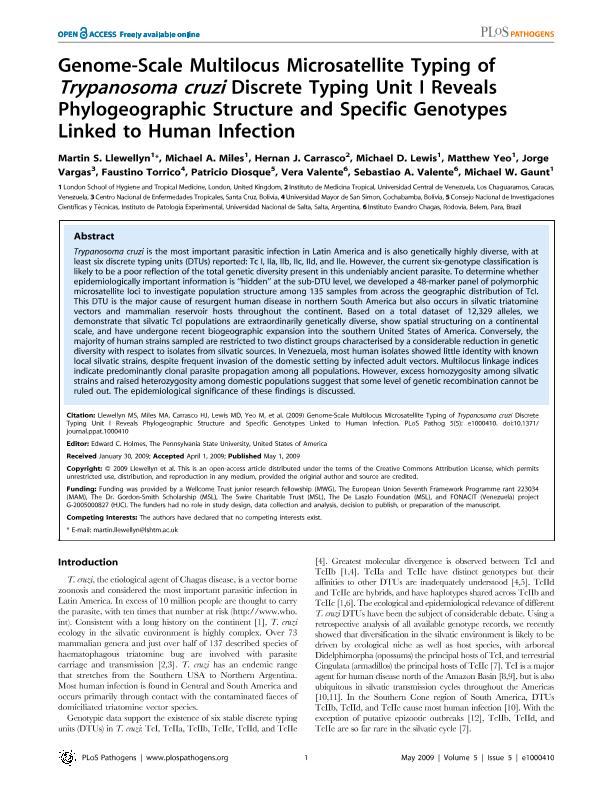Mostrar el registro sencillo del ítem
dc.contributor.author
Llewellyn, Martin S.

dc.contributor.author
Miles, Michael A.

dc.contributor.author
Carrasco, Hector Jeronimo

dc.contributor.author
Lewis, Michael D.

dc.contributor.author
Yeo, Matthew

dc.contributor.author
Vargas, Jorge
dc.contributor.author
Torrico, Faustino
dc.contributor.author
Diosque, Patricio

dc.contributor.author
Valente, Vera
dc.contributor.author
Valente, Sebastiao A.
dc.contributor.author
Gaunt, Michael W.
dc.date.available
2017-12-07T16:02:18Z
dc.date.issued
2009-05-01
dc.identifier.citation
Llewellyn, Martin S.; Miles, Michael A.; Carrasco, Hector Jeronimo; Lewis, Michael D.; Yeo, Matthew; et al.; Genome-Scale Multilocus Microsatellite Typing of Trypanosoma cruzi Discrete Typing Unit I Reveals Phylogeographic Structure and Specific Genotypes Linked to Human Infection; Public Library of Science; Plos Pathogens; 5; 5; 1-5-2009; 1-9; e1000410
dc.identifier.issn
1553-7366
dc.identifier.uri
http://hdl.handle.net/11336/29958
dc.description.abstract
Trypanosoma cruzi is the most important parasitic infection in Latin America and is also genetically highly diverse, with at least six discrete typing units (DTUs) reported: Tc I, IIa, IIb, IIc, IId, and IIe. However, the current six-genotype classification is likely to be a poor reflection of the total genetic diversity present in this undeniably ancient parasite. To determine whether epidemiologically important information is “hidden” at the sub-DTU level, we developed a 48-marker panel of polymorphic microsatellite loci to investigate population structure among 135 samples from across the geographic distribution of TcI. This DTU is the major cause of resurgent human disease in northern South America but also occurs in silvatic triatomine vectors and mammalian reservoir hosts throughout the continent. Based on a total dataset of 12,329 alleles, we demonstrate that silvatic TcI populations are extraordinarily genetically diverse, show spatial structuring on a continental scale, and have undergone recent biogeographic expansion into the southern United States of America. Conversely, the majority of human strains sampled are restricted to two distinct groups characterised by a considerable reduction in genetic diversity with respect to isolates from silvatic sources. In Venezuela, most human isolates showed little identity with known local silvatic strains, despite frequent invasion of the domestic setting by infected adult vectors. Multilocus linkage indices indicate predominantly clonal parasite propagation among all populations. However, excess homozygosity among silvatic strains and raised heterozygosity among domestic populations suggest that some level of genetic recombination cannot be ruled out. The epidemiological significance of these findings is discussed.
dc.format
application/pdf
dc.language.iso
eng
dc.publisher
Public Library of Science

dc.rights
info:eu-repo/semantics/openAccess
dc.rights.uri
https://creativecommons.org/licenses/by/2.5/ar/
dc.subject
Trypanosoma Cruzi
dc.subject
Microsatellite
dc.subject
Typing
dc.subject
Phylogeography
dc.subject.classification
Bioquímica y Biología Molecular

dc.subject.classification
Ciencias Biológicas

dc.subject.classification
CIENCIAS NATURALES Y EXACTAS

dc.title
Genome-Scale Multilocus Microsatellite Typing of Trypanosoma cruzi Discrete Typing Unit I Reveals Phylogeographic Structure and Specific Genotypes Linked to Human Infection
dc.type
info:eu-repo/semantics/article
dc.type
info:ar-repo/semantics/artículo
dc.type
info:eu-repo/semantics/publishedVersion
dc.date.updated
2017-05-29T15:38:33Z
dc.journal.volume
5
dc.journal.number
5
dc.journal.pagination
1-9; e1000410
dc.journal.pais
Estados Unidos

dc.journal.ciudad
San Francisco
dc.description.fil
Fil: Llewellyn, Martin S.. London School of Hgyene and Tropical Medicine; Reino Unido
dc.description.fil
Fil: Miles, Michael A.. London School of Hgyene and Tropical Medicine; Reino Unido
dc.description.fil
Fil: Carrasco, Hector Jeronimo. Universidad Central de Venezuela; Venezuela
dc.description.fil
Fil: Lewis, Michael D.. London School of Hgyene and Tropical Medicine; Reino Unido
dc.description.fil
Fil: Yeo, Matthew. London School of Hgyene and Tropical Medicine; Reino Unido
dc.description.fil
Fil: Vargas, Jorge. Centro Nacional de Enfermedades Tropicales; Bolivia
dc.description.fil
Fil: Torrico, Faustino. Universidad Mayor de San Simón; Bolivia
dc.description.fil
Fil: Diosque, Patricio. Consejo Nacional de Investigaciones Científicas y Técnicas. Centro Científico Tecnológico Conicet - Salta. Instituto de Patología Experimental. Universidad Nacional de Salta. Facultad de Ciencias de la Salud. Instituto de Patología Experimental; Argentina
dc.description.fil
Fil: Valente, Vera. Instituto Evandro Chagas; Brasil
dc.description.fil
Fil: Valente, Sebastiao A.. Instituto Evandro Chagas; Brasil
dc.description.fil
Fil: Gaunt, Michael W.. London School of Hgyene and Tropical Medicine; Reino Unido
dc.journal.title
Plos Pathogens

dc.relation.isreferencedin
info:eu-repo/semantics/reference/url/http://journals.plos.org/plospathogens/article?id=10.1371/journal.ppat.1000410
dc.relation.alternativeid
info:eu-repo/semantics/altIdentifier/doi/http://dx.doi.org/10.1371/journal.ppat.1000410
dc.relation.alternativeid
info:eu-repo/semantics/altIdentifier/url/http://journals.plos.org/plospathogens/article?id=10.1371/journal.ppat.1000410
Archivos asociados
